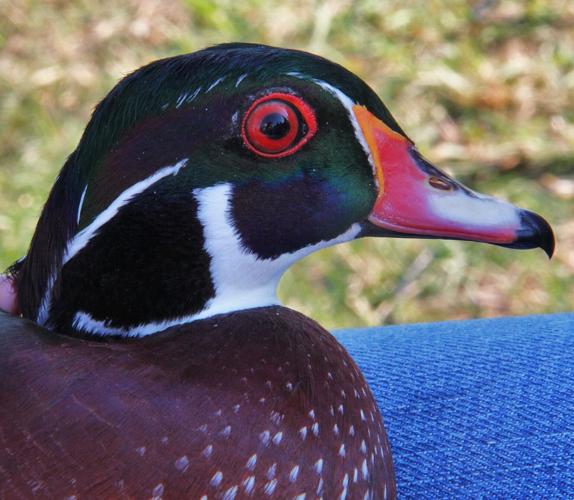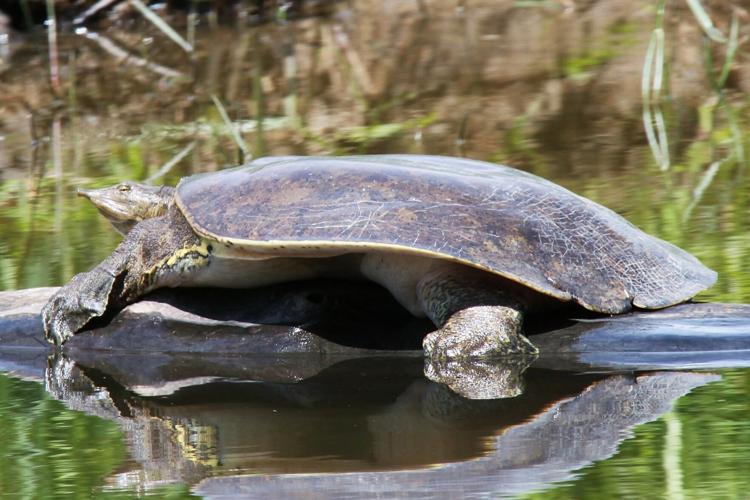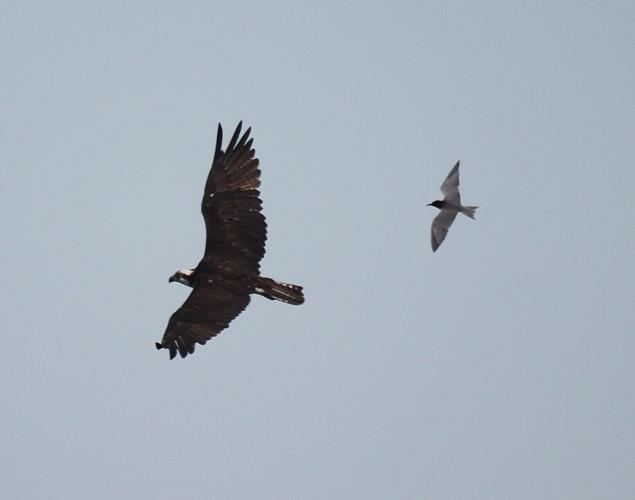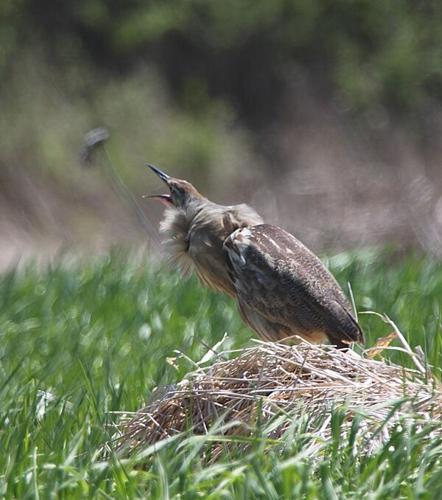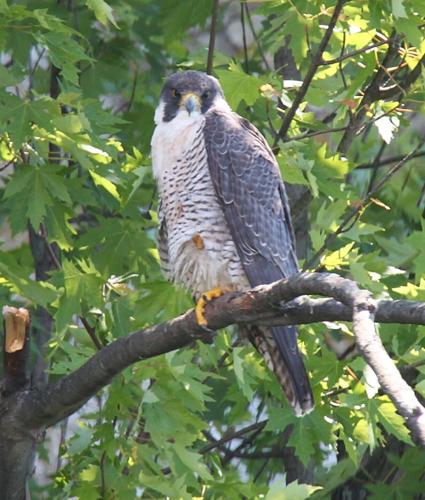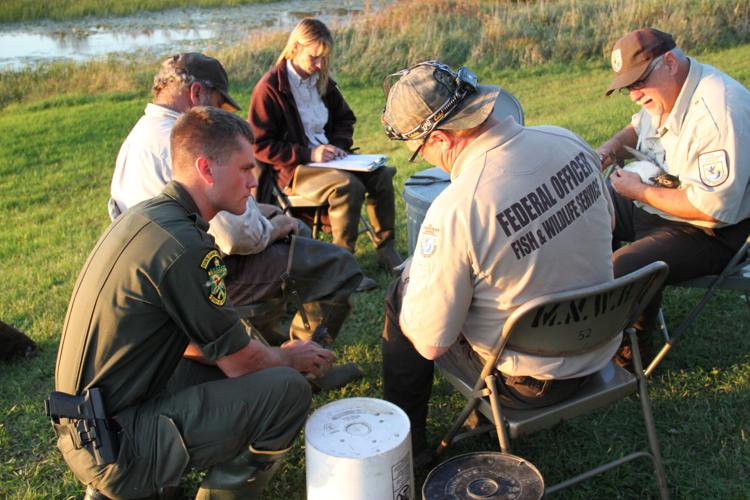SWANTON — On spring mornings, a chorus erupts from the mouth of the Missisquoi River.
Scores of birds, from Canadian geese to bobolinks, are migrating north, feeding, breeding and raising their young in the Missisquoi National Wildlife Refuge. Deer feed on the shores, while muskrats patrol the shallow waters alongside a myriad of fish, with the river itself one of the few spawning sites of Lake sturgeon in Lake Champlain.
However, budget constraints across the National Wildlife Refuge system have put a chokehold on what the skeleton crew managing the local 7,000 acre refuge can do.
The four-person team tasked with the care of the refuge consists of Ken Sturm as refuge manager, Judy Sefchick as the sole wildlife biologist, Lisa Swainbank as the office administrator and Chris Whitaker as the only maintenance employee.

From left, Julie Filiberti from the Friends of the Missisquoi Wildlife Refuge, refuge wildlife biologist Judy Sefchick, and refuge manager Ken Sturm.
The refuge
The unique habitats of the Missisquoi River delta in Swanton led it to be established as a national wildlife refuge in 1943, and a Ramsar Wetland of International Importance in 2013. Pitch pine bogs hold endangered plant species, trees lining the shore allow one of Vermont’s largest great blue heron nesting sites, and the wetland itself is the only place in Vermont that the state-endangered black tern breeds.
Elsewhere in the refuge, managed grasslands provide rare habitat for threatened birds like the Eastern meadowlark and Upland sandpipers.
Historically, the refuge had been inhabited by indigenous Abenaki dating as far back as 7,000 years ago, with spear points and pottery shards found throughout the delta.
Today, the Abenaki are still active in Swanton, through the Abenaki Nation of Missisquoi community.
The refuge has ten miles of public trails, with some closed dependent on bird nesting and hunting seasons. Visitors are required to stay on the trails at all times.

60% of the refuge is closed to the public at various times throughout the year, dependent on the breeding seasons of birds and hunting season. Photo courtesy of Ken Sturm.
Sefchick’s daily biological work, during the spring, summer and fall, can range from removing pounds of invasive species like water chestnuts to tracking the nesting sites of endangered species like the black tern or bald eagles.
“If I leave or take a vacation for a week, nothing gets done in biology,” Sefchick told the Messenger. “[I] come back and [I] think, ‘Why did I do that?’ [I] just have that much more work to do.”
Sefchick said the refuge is one of the most unique places in Vermont and the Northeast, home to an incredible amount of threatened species.
In recent years, Sefchick said biologists have learned so much about native insect species, including the federally-endangered rusty patched bumblebee.
“In 20 years, 10 years, five years, who knows how many of those species are going to be gone?” Sefchick said. “This refuge has unique habitats and unique species, and the fact that it’s closed to the public in certain areas, it’s a treasure trove of species and habitats and plants that you aren’t going to see elsewhere in Vermont.”
Missisquoi staffing shortage
On the Missisquoi refuge, staffing shortages directly affect the daily lives of all four employees.
Refuge manager Sturm said with less staff and less funding, the current staff and refuge directly suffers. Sefchick can’t work on her biological projects as effectively, illegal activity increases, equipment fails and visitors can’t learn or see what they should be seeing.
“I had an afro when I started this job,” Sturm joked. “I’m losing hair and getting wrinkles.”
Over the summer 2022, the refuge’s visitor center had to rely on volunteers from groups like the Friends of the Missisquoi National Wildlife Refuge to keep the building open for a few short hours a few days a week.
For larger projects that would help Sefchick, volunteers would need constant supervision as they’re not trained biologists. While people would like to volunteer, work done on protected federal land often requires numerous training for operating equipment and specialized training for biological work.
It’s a lot to ask of volunteers, Sturm said.
At bare minimum, Sturm said the refuge should have about seven employees: the current four, plus a refuge operations specialist, a dedicated law enforcement officer and a volunteer and education employee.
“We’re just hanging on,” Sturm said.
Ideally, the more the better. Sefchick’s work often requires more than one person, and that means half of the staff can be gone at one time. Similarly, Sefchick working alone can be dangerous, especially with old equipment.
Sefchick referenced a time when she, working alone, had to be towed back into the refuge by a boater after drifting into the Missisquoi Bay when her boat’s motor was broken and she couldn’t fix it by herself.

The entire population of Black terns in Vermont nests on the Missisquoi refuge. Photo courtesy of Ken Sturm.
Not being able to educate the public as effectively as they should be is another huge loss for the refuge system, Sturm said.
“If we’re out in the field, we just lock up the doors,” Sturm said. “Probably 75% of the time the doors were closed up last year. For a facility like this and a resource that this provides, it’s a real shame.”
He said in Franklin County, refuge staff should be able to educate local students on how phosphorus runoff or invasive species impact Lake Champlain, or show them the hundreds of species that call their backyards home. In Chittenden County, educational outreach can connect underserved communities like Winooski to natural areas within an hour’s drive.
“We started saying no to a lot of school groups and camps that wanted to have programming,” Sturm said. “We had to say if you can do the program yourselves, you can have the facility, you can walk the trails, but we don’t have the staff to talk about anything on the refuge.”
In addition, not having a dedicated law enforcement officer on the refuge puts the staff and environment at risk.
Sefchick said she’s out on a boat nearly every day from the spring to the fall, and is often the one to come across illegal fishing or hunting, trespassing and dumping.
The closest officer who can respond to anything refuge-specific is located in Massachusetts. According to the National Wildlife Refuge Association, 214 law enforcement officers are responsible for the 850 million acres of refuge nationally, averaging nearly 4 million acres per officer.
The refuge does have a Fish and Wildlife special agent, but because federal divisions focus agents on specific law enforcement, special agent Eric Holmes’ main focus isn’t protecting the refuge. Instead, special agents focus on specific issues or wildlife laws, instead of refuge-specific violations like trespassing or prohibited camping.
While Holmes has prosecuted a few people for refuge violations, Sturm said he’s far-flung, occasionally responding to situations ranging from Minnesota to Rhode Island.
“We deal with things all the time that our refuge staff probably shouldn’t be dealing with,” Sturm said.
Recently, for example, there was a burglar alarm call going off at the refuge center and he was the one to respond, sitting in the parking lot “looking for someone to come out with a wheelbarrow full of laptops.”
While the call was a false alarm, the refuge staff are on the front lines against people illegally dumping, poaching or trespassing on delicate habitats across the refuge. With no dedicated law enforcement, staff said most violations will slip through the cracks.
Sturm said they can still call local authorities, but they don’t expect officers to go beyond their typical duties.
National budget issues
Nationally, every refuge is strained.
The National Wildlife Refuge Association, a nonprofit organization that advocates for the federal refuge system, started a campaign in January 2023 to convince decision makers in Washington, D.C., to increase funding.
According to the NWRA, the system was appropriated $503 million in 2009. Keeping up with inflation, they should receive around $690 million per year. However, actual funding is currently $541 million to cover 850 million acres of refuges.

According to the NWRA, the refuge system is receiving half the funding they should be, if inflation is accounted for. Courtesy graph.
The Missisquoi refuge operates on $600,000, covering 7,000 acres. This budget accounts for salaries for the four employees, maintenance costs for buildings, equipment and projects.
In the Inflation Reduction Act, passed in 2022, the National Parks system was granted almost $1 billion to hire new staff and respond to climate change, on top of the $3.6 billion appropriated for 2022. For comparison, the National Park system covers 85 million acres, a tenth of what the refuge system holds.
In the same act, the refuge system was allocated an additional $120 million to fund projects that are proven to help combat climate change in habitats and fight invasive species, but not to fund an increase in staff.
“We know that Congress is willing and capable to appropriate funds just for that purpose,” said Libby Marking, the association’s director of government affairs and public policy. “So we’re pushing for it now for the refuge system.”
A campaign release from the NWRA said more than half of the refuges across the country have zero staff, and some refuges have staff hours away. From the Missisquoi, Sturm manages the land and waters in Swanton, land on Lake Memphremagog, and land in northern New York near the town of Malone.
Now, the NWRA has estimated the country-wide refuge system needs an additional $560 million to hire enough staff to fully staff each refuge, to bring the system’s total budget to $1.5 billion.
In 2009, the refuge system had approximately 3,200 full-time employees. Now, they have about 2,400, and Marking said a fully-staffed refuge system should have about 7,200 employees.
The impact of COVID-19 increased visitation numbers on the refuge dramatically, up 34% from 2010 to 67 million in 2022, according to the NWRA.
Eden Taylor, the NWRA communications manager, works closely with a number of refuge groups like the Friends of Missisquoi to hear what happens on the ground, and she said they’ve all reported similar experiences.
“A lot of people wanted to get outside, and they wanted to be on the refuge,” Taylor said. “People found the refuges and they really love them, and they’ve been coming back now. So those visitation numbers that we’re seeing are really high, and they’re sticking around.”
Raising awareness
Compared to National Parks, refuges are drastically different. With no entrance fees to the Missisquoi and 60% of the land closed to the public, the refuge focuses on protecting species rather than eco-tourism.
The major difference in funding could be explained by what the systems produce as well; the National Park system generates a profit, through passes into parks and permits for specific hikes like in Yosemite National Park, along with major impacts to local economies through hotels and restaurants for travelers.
“The difference between the refuge system and the Park Service is that we are established for wildlife and wildlife conservation, public use is secondary to our purpose,” Sturm said. “We allow public use to occur when and where it’s compatible with the purpose the refuge was established for.”
Both the NWRA and Missisquoi staff said they are not critiquing the National Parks Service or other organizations for their work, but would like to see more funding spread to the refuge program.
Although the refuge system is focused on wildlife habitat and not human enjoyment, refuge associates said there are still ways for the public to help.
“We’re trying to build up that grassroots effort, build up that power on the ground and make it a local issue,” Marking said.
Marking said the NWRA has been hosting webinars and putting resources online through social media to help educate people on how to write a letter to their representatives or get involved on social media.
“We’re also working with a lot of the other national partners on this so we can tap into their grassroots networks as well,” Marking said. “I think the reason why folks like the National Parks Services and other agencies have been so successful and getting their message out is because they have all this great, widespread, very public messaging about it.”

Bald eagles and ospreys call the Missisquoi home, nesting in trees and on artificial platforms. Courtesy of Ken Sturm.
At the Missisquoi refuge, they’ve been helped by donations from individuals and groups like Franklin County’s chapter of 100 Women Who Care and by the work of volunteers, but that’s only provided small boosts for specific programs.
“Individually funding one refuge may not be the answer,” Sturm said. “It needs to be a nationwide push for increased funding to meet the current existing needs, plus the anticipated and known future needs of habitat management and the conservation system.”
To learn more about work done on the Missisquoi National Wildlife Refuge, visit www.fws.gov/refuge/missisquoi. For the Friends of the Missisquoi Refuge, visit www.friendsofmissisquoi.org.
More information about the NWRA’s campaign for more funding can be found at www.refugeassociation.org/the-refuge-staffing-crisis.

